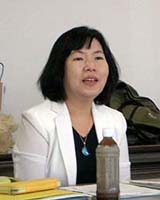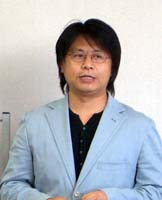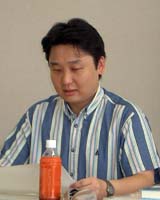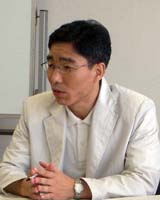
(1)The Japanese term can be read both ways. It is sometimes translated as “I-novel.”

![]()
![]()
![]()
![]()
![]()
(1)The Japanese term can be read both ways. It is sometimes translated as “I-novel.”
Workshop 1: Recognition of the watakushi shôsetsu/shi shôsetsu in Japan, China, and Korea, and the problem of language (Hosei University, Hachinen-kan) |
Schedule 8/21/2006 (Monday) 8/22/2006 (Tuesday) 8/23/2006 (Wednesday) |
Report Jin Myoung Sun, Youngsan University |
 |
This paper collects and analyzes documents concerning how the Japanese watakushi shôsetsu/shi shôsetsu was perceived in Korea, especially in the area of Pusan. With Pusan as its focus, it takes as its main subject those people who participated in Japan-related scholarship and education, specifically, active university professors. It establishes that, perhaps because the majority had been to study in Japan and had a high degree of interest in Japan, there were almost none who did not know of the form, and so all had some conception of it. One result of the survey was that the author was introduced to Korean writers who were influenced by the watakushi shôsetsu/shi shôsetsu, and was thus provided with topics for further exploration. In addition, the writer points out that, although there was no phenomenon of a watakushi shôsetsu/shi shôsetsu tradition in Korea, this was an effect of the state of Korean society, the cultural tradition, and the role of modern literature, and he emphasizes the necessity of comparing this in a complex way with the case of Japan. (Kangwoo Won Young) |
Yang Tian Xi, Hirosaki University |
 |
Chinese is a language using only kanji. Its grammatical structure is basically SVO, verbs do not conjugate, and the sentence endings are grammatically variable. These are some of the distinctive characteristics of the language. Japanese, however, uses bothkanji and kana, its verbs conjugate, and sentence endings tend to be limited. Furthermore, if we look at grammatical person, there is only one first-person pronoun and one second-person pronoun in modern Chinese, and this is quite different from Japanese. In particular, because the first-person [wo] has a multiple character, it is difficult to use this person in narrative fiction. Because the special character of a Japanese-language approach to writing manifests itself in details, there is a great deal of concrete description and subtle expression of sensation. But Chinese-language expression manifests itself in the broader structure of a work. In short, Yang asserts that there is no possibility of a perfect translation between Chinese and Japanese, due to the difference in their structures. (Peng Dan) |
Kangwoo Won Young, Han Yang University |
 |
Kangwoo’s presentation is a preliminary report on an investigative survey currently being conducted in China, South Korea, and Taiwan. The subject of this research is a consideration of the watakushi shôsetsu/shi shôsetsu through a comparison with East Asia, and it is important first to know how the form is recognized in each country. According to this presentation, in Korea there is a high degree of recognition of the watakushi shôsetsu/shi shôsetsu, and it holds interest as a form unique to modern Japanese literature. However, it seems that the presenter is wondering whether the concept is truly understood, since that recognition comes from academic writings and follows the conventional narrative of Japanese literary history. As a theme going forward, it will be necessary to investigate why the formdid not flourish in Korea, despite the fact that during the colonial period there were many writers influenced by Japanese literature. The results of this survey are to be summarized and published in a journal. (Umezawa Ayumi) |
Lee Han Jung, Han Yang University |
 |
This presentation concerns recognition of the watakushi shôsetsu/shi shôsetsu in Korea and a consideration of the form from the aspect of the difference between the Korean and Japanese languages, as manifested in translated works. First of all, while touching on academic writings concerning Japanese literature in Korea, Lee investigates the recognition, among recent scholars of Korean literature, of watakushi shôsetsu/shi shôsetsu, a term which did not have a unique meaning in earlier Korean literature. In addition, he addresses the nature of the Korean language (that is, its points of difference with Japanese), such as the problem of subject, which in Korean cannot be omitted from independent sentences out of context; of first-person pronouns, which are not as various as in Japanese; and of the rejection of verb-tense nonagreement; and Lee tries to clarify the structure of the languages through a painstaking comparative analysis of the original text and the Korean translation of such watakushi shôsetsu/shi shôsetsu as Shiga Naoya’s “Kinosaki nite” (“At Kinosaki”) and Shimao Toshio’s “Yume no naka de no nichijô” (“Everyday Life in a Dream”). It is a thoughtful paper that approaches the form from the problem of the structure of language. (Yamanaka Hideki) |
→next report (Research Session 1)
| Workshop 1 Research Session 1 Workshop 2 |
|---|
Top Page (The Japanese Watakushi shôsetsu/Shi shôsetsu as Seen in Relation to Asian Culture) Top Page(the Watakushi shôsetsu/shi shôsetsu Research Group of the Graduate School of Hosei University) |
|---|